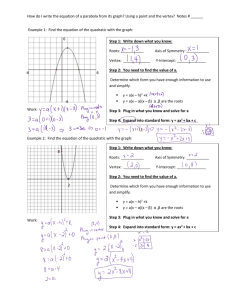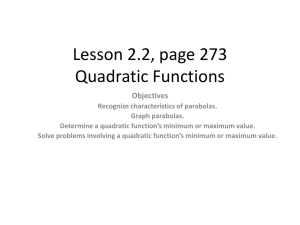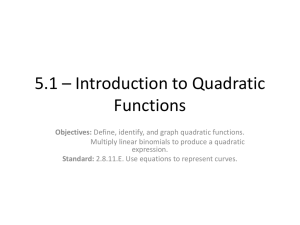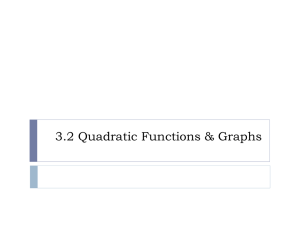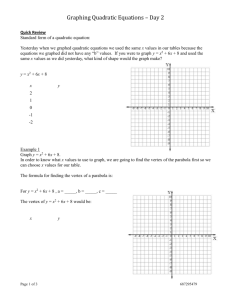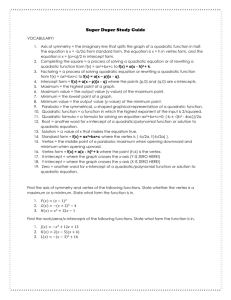Chapter 4 Notes 4.1A Graph Quadratic Functions in Form f(x) = ax2
advertisement
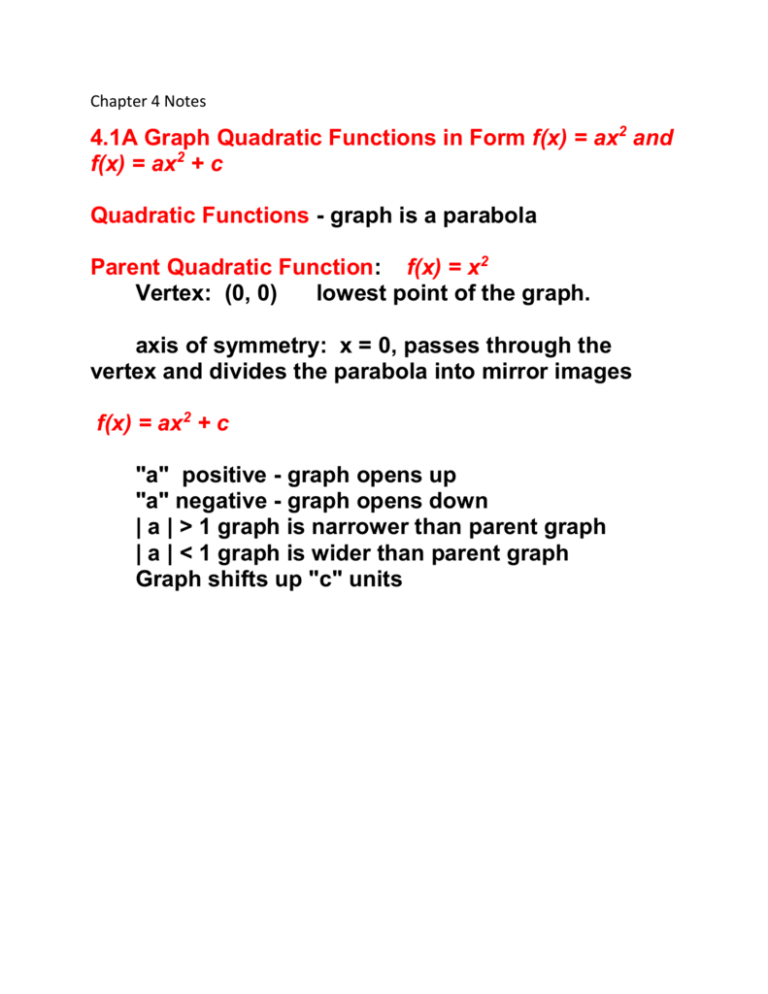
Chapter 4 Notes 4.1A Graph Quadratic Functions in Form f(x) = ax2 and f(x) = ax2 + c Quadratic Functions - graph is a parabola Parent Quadratic Function: f(x) = x2 Vertex: (0, 0) lowest point of the graph. axis of symmetry: x = 0, passes through the vertex and divides the parabola into mirror images f(x) = ax2 + c "a" positive - graph opens up "a" negative - graph opens down | a | > 1 graph is narrower than parent graph | a | < 1 graph is wider than parent graph Graph shifts up "c" units 4.1B Graph Quadratic Functions in the Form y = ax2 + bx + c Characteristics: a > 0 graph opens up a < 0 graph opens down |a| > 1 graph is more narrow than parent graph |a| < 1 graph is wider than parent graph x = -b axis of symmetry 2a -b x - coordinate of the vertex, vertex is maximum 2a when graph opens down, minimum when graph opens up. c is the y-intercept so point (0,c) is on the graph Graph: 1. Plot the vertex 2. Graph the line of symmetry 3. Make a table and plot and label 4 points 4. Draw the parabola (arrows) 4.2 Graph Quadratic Function in Vertex Form Vertex Form: y = a(x - h)2 + k Characteristics: Parabola y = ax2 translated horizontally h units and vertically k units Vertex (h, k) Axis of symmetry is x = h a > 0 graph opens up a < 0 graph opens down Graph: Vertex, 4 other points, axis of symmetry Graph Quadratic Function in Intercept Form Intercept Form: y = a(x - p)(x - q) Characteristics: x-intercepts are (p, 0) and (q, 0) Axis of symmetry is half way between x-intercepts x=p+q 2 a > 0 graph opens up a < 0 graph opens down Graph: Vertex, line of symmetry, and x-intercepts 4.3/4.4 Solve Quadratic Equations by Factoring Standard Quadratic Equation: ax2 + bx + c = 0 1. Set equation equal to zero 2. Factor 3. Use the Zero Product Property ZPP If the product of two expressions is zero, then one or both of the expressions equal zero. AB = 0, then A=0 or B=0 Zeros of the function: Solutions are the x-intercepts because the function equals zero. 4.5 Solve Quadratic Equations by Finding Square Roots Properties of Square Roots ( a> 0, b > 0 ) Product Property Quotient Property Rationalizing the denominator Multiply by the radical or the conjugate Solve: 1. Isolate the variable squared term or quantity 2. Take the square root of each side 3. Simplify 4. Check 4.6 Perform Operations with Complex Numbers Complex Numbers Imaginary i = √-1 Real irrational rational integers whole counting i= √-1 =i i2 = (√-1)2 = -1 i3 =-1(i ) = -i i4 = -1(-1) =1 complex number a + bi Add, subtract, or multiply using i as a variable Divide complex - multiply by the conjugate Complex plane - horizontal is the real axis vertical is the imaginary axis Absolute value of a complex number z = a + bi, denoted |z|, is a nonnegative real number defined as distance between z and the origin in the complex plane. |z| = √a2 + b2 4.7 Complete the Square 1. Complete the square to write perfect square equation a. divide each term by the x2 coeffient b. Isolate the quadratic and linear term on 1 side c. Add half of b squared to both sides d Write as binomial squared 2. Solve using the square root method 3. Simplify 4. Check Write quadratic functions in vertex form by completing the square. y = a(x - h)2 + k 4.8 Use the Quadratic Formula to Solve Quadratic Equations ax2 + bx + c = 0 x = (-b ± √(b2 - 4ac))/2a Discriminant b2 - 4ac > 0 2 real solutions b2 - 4ac = 0 1 real solution b2 - 4ac < 1 no real solutions Motion Problems: object is dropped h = -16t2 + ho object is thrown h = -16t2 + vot + ho 4.9 A Graph and solve Quadratic Inequalities in 2 Variables quadratic inequality in two variables: y < ax2 + bx + c y > ax2 + bx + c y < ax2 + bx + c y > ax2 + bx + c Graph: * Graph the parabola (vertex and 4points) * Test a point inside or outside the parabola * Shade the true area Systems of quadratic inequalities: *Graph, Test, & Shade each inequality *The solution is where the shadings overlap - shade darker 4.9B Graph and solve Quadratic Inequalities in 1 Variable quadratic inequalities in one variable: ax2 + bx + c < 0 ax2 + bx + c > 0 ax2 + bx + c < 0 ax2 + bx + c > 0 Solve by using a table: *Rewrite the inequality in standard form *Make a table of values *Write an inequality statement where for the x values where it fits the inequality statement Solve by graphing: *Find the graph's x-intercepts by setting equation = 0 *Graph the equation y = ax2 + bx + c using the vertex and x-intercepts *The solution consists of the x-values for which the graph of y = ax2 + bx + c lies above x-axis for >, below x-axis for <. 4.9B Graph and solve Quadratic Inequalities in 1 Variable quadratic inequalities in one variable: ax2 + bx + c < 0 ax2 + bx + c > 0 ax2 + bx + c < 0 ax2 + bx + c > 0 Solve by using a table: *Rewrite the inequality in standard form *Make a table of values *Write an inequality statement where for the x values where it fits the inequality statement Solve by graphing: *Find the graph's x-intercepts by setting equation = 0 *Graph the equation y = ax2 + bx + c using the vertex And x-intercepts *The solution consists of the x-values for which the graph of y = ax2 + bx + c lies above x-axis for >, below x-axis for <. Solve algebraically: *Write an equation in standard form *Solve by factoring (ZPP) *Plot the critical x-values on a number line *Test an x value in each of the intervals to see which Intervals satisfy the inequality statement *Write the inequality solution 4.10 Write Quadratic Functions Vertex Form: y = a(x - h)2 + k Given: vertex 1 point *substitute the point and vertex to solve for "a" Intercept Form: y = a(x - p)(x - q) Give: x-intercepts 1 point *Substitute the point and intercepts to solve for "a" Standard Form: y = ax2 + bx + c Given: 3 points *Write a system of three equations, three variables *Use matrix equation or row operations to solve for a,b,c
